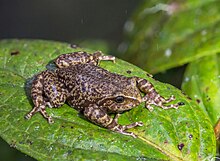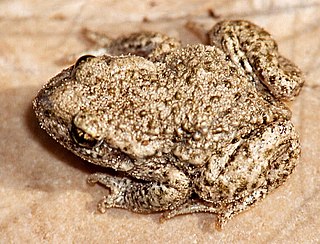
The Alytidae are a family of primitive frogs. Their common name is painted frogs or midwife toads. Most are endemic to Europe, but three species occur in northwest Africa, and a species formerly thought to be extinct is found in Israel.

Telmatobius is a genus of frogs native to the Andean highlands in South America, where they are found in Ecuador, Peru, Bolivia, northwestern Argentina and northern Chile. It is the only genus in the family Telmatobiidae. Some sources recognize Batrachophrynus as a valid genus distinct from Telmatobius.

Osteocephalus is a genus of frogs, the slender-legged tree frogs, in the family Hylidae found in the Guianas, the Amazon Basin, Venezuela, Colombia, southeastern Brazil, and north-eastern Argentina. Males are warty, while females are smooth.
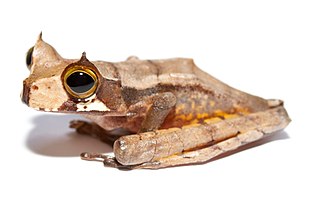
Gastrotheca is a genus of frogs in the family Hemiphractidae. They are found in Central America south of Costa Rica and in South America. Most species occur in the American Cordillera from southern Costa Rica to north-western Argentina. This genus makes up the bulk of marsupial frog diversity; formerly it was placed in the "Leptodactylidae" assemblage.

Oreobates is a genus of frogs in the family Strabomantidae. Most species were formerly in the genus Ischnocnema, but were moved to this revalidated genus following a 2006 revision. Its sister taxon is Lynchius.

Pristimantis katoptroides is a species of frog in the family Strabomantidae. It is found in the eastern slopes of the Andes of Ecuador and Cordillera Central and eastern Andean foothills in northwestern Peru. The specific name katoptroides is Greek for "mirror-like" and refers to the similarity of this species to Pristimantis crucifer, but being found on the other side of the Andes. Common name Puyo robber frog has been proposed for it.

Oreobates quixensis, also known as the common big-headed frog, is a species of frog in the family Strabomantidae. It is found in the upper Amazon Basin in Bolivia, western Brazil, Colombia, Ecuador, and Peru. It is a very common terrestrial frog of primary and secondary tropical moist forest, also to be found in clearings, open areas and banana groves.
Noblella lochites, also known as Ecuador leaf frog, is a species of frog in the family Strabomantidae. It is found on the Amazonian slopes of the Andes and Cordillera del Cóndor and the Cordillera de Cutucú in Ecuador and Peru; the Peruvian record has been disputed, although it is nevertheless expected that the species occurs in Peru.

The Petropedetidae are a family of frogs containing three genera and 12 species. They are found in sub-Saharan tropical Africa and are sometimes known under common name African torrent frogs.
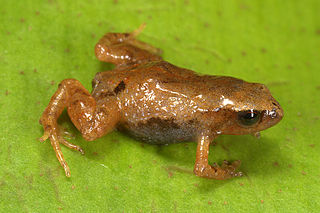
The Strabomantidae are a family of frogs native to South America. These frogs lack a free-living larval stage and hatch directly into miniature "froglets". This family includes Pristimantis, the most speciose genus of any vertebrate.

Craugastoridae, commonly known as fleshbelly frogs, is a family of New World direct-developing frogs. As delineated here, following the Amphibian Species of the World, it contains 129 species. They are found from the southern United States southwards to Central and South America.

Strabomantis is a genus of frogs in the family Strabomantidae. At times these frogs have been included in the large genus Eleutherodactylus. They are distributed from Costa Rica southwards to northern South America.

Engystomops is a genus of frogs in the family Leptodactylidae. They are known commonly as foam frogs or túngara frogs, though the latter name most commonly refers to Engystomops pustulosus. They are native to the Americas from southern Mexico south to the Amazon Basin.
Pristimantis minimus is a minute frog from the family Strabomantidae. It is found in the Cordillera del Cóndor at elevations between 1,250–1,685 m (4,101–5,528 ft) asl on either side of the valley of the Rio Nangaritza, in the Zamora-Chinchipe Province of Ecuador. The species is the smallest known frog found in Ecuador to date, and is the smallest in the genus Pristimantis. It is suggested that this miniaturization is an adaptation to resource-poor environments.

The Alsodidae are a small family of frogs from South America between Patagonia and southern Brazil. It contains 30 species in three genera. This family, along with several other families, used to be included in the family Leptodactylidae. It was then a subfamily in the family Cycloramphidae, before being recognized as a family first in 2011.

Yunganastes is a small genus of frogs in the family Strabomantidae found in southern Peru and central to northern Bolivia. They were formerly placed in the genus Eleutherodactylus as the "Eleutherodactylus fraudator group", subsequently moved to Pristimantis, before becoming recognized as a separate subgenus, and finally, a genus. Its sister taxon is the genus Pristimantis. Yunganastes are endemic to the cloud forests and humid montane forests of the Cordillera Oriental of the Andes in Bolivia and southern Peru.

Hylodidae, commonly known as giant Neotropical torrent frogs, is a family of frogs native to Brazil and northern Argentina. Phylogenetic evidence suggests the Hylodidae being the sister group to the Alsodidae.

The Leiuperinae are a subfamily of frogs in the family Leptodactylidae. Over 90 species are in five genera. The distribution of this subfamily is from southern Mexico to the Central America and much of South America.

Noblella is a genus of frogs in the family Strabomantidae. They are found on the eastern slopes of the Andes and in the Amazon Basin in Colombia, Ecuador, Peru, Bolivia, and western Brazil. The name refers to Gladwyn K. Noble, who described the first species.
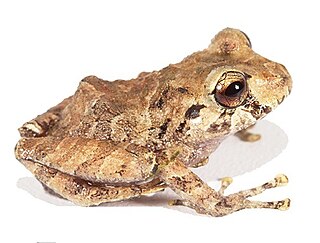
Pristimantis mallii is a species of frog in the family Strabomantidae. It is endemic to Ecuador. Described in 2019, it is only known from the Río Zuñag Reserve on the eastern slope of the Andes, in the upper basin of the Pastaza River. The specific name mallii honors V. N. Mallikarjuna "Malli" Rao, winner of Lavoisier Medal who helped develop an environmentally safe alternative to the fluorocarbons and whose donation helped establish the Río Zuñag Reserve. Common name Malli's rain frog has been coined for this species.
